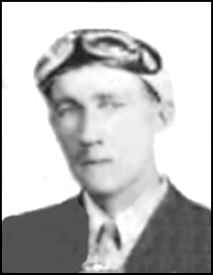
1888-1970 |
 |
Collection of Stephen Browne, 10-2-05 |
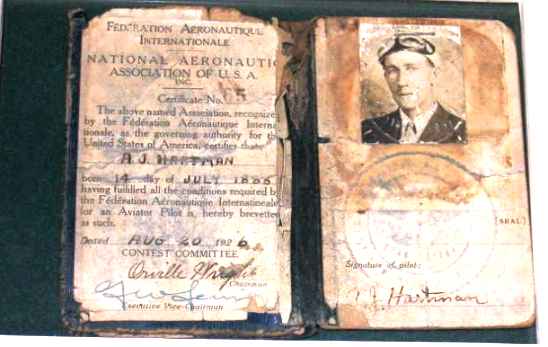 |
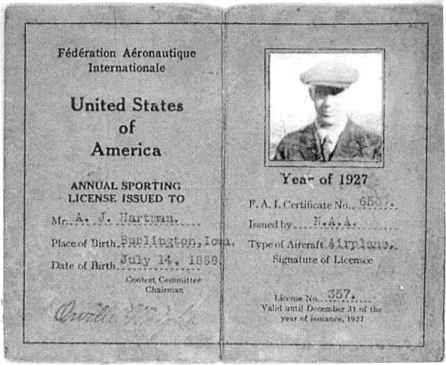 |
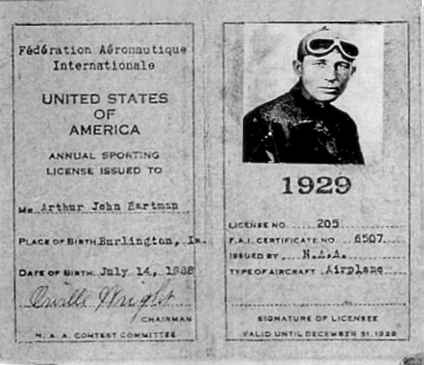 |
Collection of Stephen Browne, 10-2-05 |
|
Hartman Air-Bike |

|
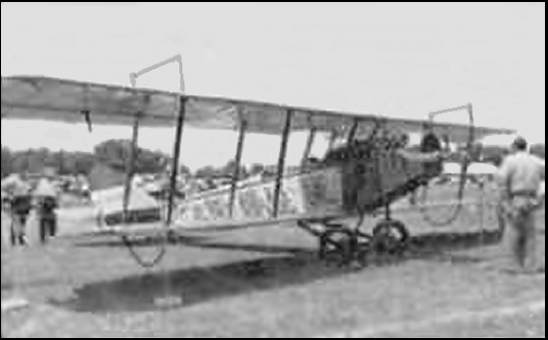 |
(Rockford, Ill., Register-Republican, August 4, 1961 But Hartman soloed in a balloon, while Wright's first solo was also the first successful flight of a powered, heavier-than-air-craft. Hartman's still flying, and he'll prove it tonight at 7:30 over Greater Rockford Airport by demonstrating the World War I-type Curtiss OX5-powered Jenny he built himself. He may be the nation's only pilot still flying actively after 57 years. Hartman will mark his 58th year of flying next month. He soloed in a balloon Sept. 6, 1903. Why does he continue to fly? "I got tired of looking at four walls. I told my wife I'd either go crazy or start knocking the walls down." Hartman Says. That was after he sold his old Bleriot-type monoplane in 1956 to a museum. Hartman built that plane himself in 1910. He barnstormed in it from 1939 until he sold it. If you think piloting a Jenny is a rather strenuous hobby for a senior citizen, you'd probably think flying a Bleriot-type plane is too strenuous for any age. Some who have tried it agree. The Bleriot has the appearance, but not the maneuverability, of a prehistoric flying lizard. When inactivity got too grinding, Hartman started the Jenny project. He located a number of plans, but they didn't jibe, so he actually built most of the plane from memory. He says he told Mrs. Hartman he had two main reasons for the project. First, he considers it the most important plane of all, since it was the one used to train hundreds of World War I pilots, some of whom are among the nation's most noted fliers. "And I wanted to recognize my early flying friends," Hartman states. The Jenny is virtually a flying honor roll of aviation. Its fuselage bears the names of dozens of famous fliers. A random sampling includes Gen. Frank P. Lahm, Jimmy Doolittle, Clyde V. Cessna, Jack Knight, Benny Howard, L. D. Rockwell, Glenn L. Martin, Jimmy Mattern, Col. Roscoe Turner, Arthur Godfrey, Ruth Law, Blanche C. Scott, and Roy Knabenshue The plane is destined for a museum when Hartman is through with it. "I started in the 'starvation days' of flying," he reminisces. |
|
Arthur J. Hartman, pioneer aeronaut and aviator, died in Burlington, Iowa, Memorial Hospital Saturday
OCtober 19, 1970 at THE age of 82. Art Hartman, the son of Kosmas and Wilhemina Hartman was born July 14, 1888 in
Burlington, Iowa. At the age of 15, he ran away from home to become an aeronaut; his first jobs were parachute jumps from
balloons. He made his first solo flight in a balloon September 6, 1903. Despite his love for balloons, he was convinced that
the future of powered flight lay in heavier-than-air craft, and before he was 22, he had built a monoplane. He tested it on
May 10, 1910, taking off from a section of the Burlington Golf Club. After World War I, Art began rebuilding cracked-up airplanes, left over from the war, and sold them to would-be fliers. From this he moved into the manufacture of airplanes, heading his own firm, Burlington Airplane Company. Surviving are his wife; two sons, Arthur C. Hartman, Wichita, Kansas and Paul K. Hartman, Neosho, Missouri, three daughters, Mrs. Marilyn Eisenhart, Napa, California, Mrs. Jeanette Winegard, Mediapolis, Iowa, and Mrs. Marguerite Jankowski of Burlington; a brother, Clarence Hartman of Burlington; 15 grandchildren and seven great-grandchildren Back 

|